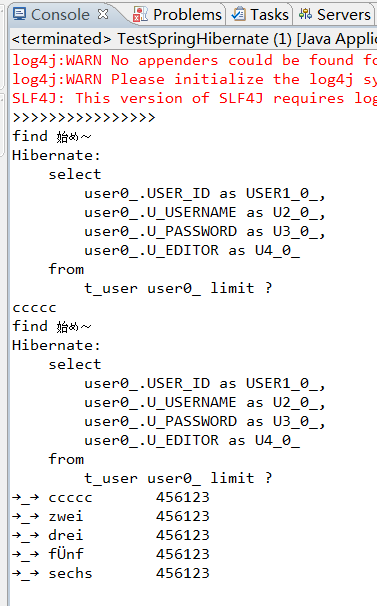~Spring+Strtus2+Hibernate的整合案例~
项目结构:ლ(╹◡╹ლ)请无视过滤器、监听器以及CKEdtior等……
配置文件都在WEI-INF下,web.xml和applicationContext.xml主要配置↓↓↓↓↓↓↓↓↓↓↓↓↓↓
web.xml:
<!-- 启动服务器时,实例化Spring容器 -->
<context-param>
<param-name>contextConfigLocation</param-name>
<!-- 指定Listener要加载的Spring配置文件 -->
<param-value>/WEB-INF/applicationContext.xml,classpath*:applicationContext.xml</param-value>
</context-param>
<!-- 启动服务器时实例化Listener对象,此时实例化Spring容器对象 -->
<listener>
<!-- <listener-class>org.springframework.web.context.ContextLoaderListener</listener-class> -->
<listener-class>com.web.listener.CountLineListener</listener-class>
</listener>
<!-- 设置session超时时间 -->
<session-config>
<session-timeout>60</session-timeout>
</session-config>
<!-- 配置前端控制器 -->
<filter>
<filter-name>struts2</filter-name>
<filter-class>org.apache.struts2.dispatcher.ng.filter.StrutsPrepareAndExecuteFilter</filter-class>
<!-- <filter-class>org.apache.struts2.dispatcher.FilterDispatcher</filter-class>-->
</filter>
<filter-mapping>
<filter-name>struts2</filter-name>
<url-pattern>/*</url-pattern>
</filter-mapping>
applicationContext.xml:
<!-- 让spring注入SessionFactory <bean id="sessionFactory" class="org.springframework.orm.hibernate3.LocalSessionFactoryBean"> <property name="configLocation" value="classpath:hibernate.cfg.xml"></property> </bean> --> <bean id="userDao" class="com.dao.impl.UserDaoImpl"> <property name="mySessionFactory" ref="mySessionFactory"></property> </bean> <bean id="userService" class="com.service.impl.UserServiceImpl"> <property name="userDao" ref="userDao"></property> </bean> <bean id="userAction" class="com.web.action.UserAction" scope="prototype"> <property name="userService" ref="userService" /> </bean> <bean id="editorAction" class="com.web.action.MyEditor" scope="prototype"> <property name="userService" ref="userService" /> </bean> <!-- 数据源->连接数据库 --> <bean id="myDataSource" class="org.apache.commons.dbcp.BasicDataSource" destroy-method="close"> <property name="driverClassName" value="com.mysql.jdbc.Driver"/> <property name="url" value="jdbc:mysql://localhost/test"/> <property name="username" value="root"/> <property name="password" value="root"/> </bean> <bean id="mySessionFactory" class="org.springframework.orm.hibernate3.LocalSessionFactoryBean"> <property name="dataSource" ref="myDataSource"/> <property name="mappingResources"> <list> <value>com/entity/User.hbm.xml</value> </list> </property> <property name="hibernateProperties"> <!-- <value>hibernate.dialect=org.hibernate.dialect.MySQLDialect</value> --> <props> <prop key="hibernate.dialect">org.hibernate.dialect.MySQLDialect</prop> <prop key="hibernate.show_sql">true</prop> <prop key="hibernate.format_sql">true</prop> </props> </property> </bean> <!-- 事物管理 --> <bean id="txManager" class="org.springframework.orm.hibernate3.HibernateTransactionManager"> <property name="sessionFactory" ref="mySessionFactory"></property> </bean> <!-- 配置事物通知 下面是Spring中Propagation类的事务属性详解: REQUIRED:支持当前事务,如果当前没有事务,就新建一个事务。这是最常见的选择。 SUPPORTS:支持当前事务,如果当前没有事务,就以非事务方式执行。 MANDATORY:支持当前事务,如果当前没有事务,就抛出异常。 REQUIRES_NEW:新建事务,如果当前存在事务,把当前事务挂起。 NOT_SUPPORTED:以非事务方式执行操作,如果当前存在事务,就把当前事务挂起。 NEVER:以非事务方式执行,如果当前存在事务,则抛出异常。 NESTED:支持当前事务,如果当前事务存在,则执行一个嵌套事务,如果当前没有事务,就新建一个事务。 --> <tx:advice id="txAdvice" transaction-manager="txManager"> <tx:attributes> <tx:method name="add*" propagation="REQUIRED"></tx:method> <tx:method name="del*" propagation="REQUIRED"></tx:method> <tx:method name="modi*" propagation="REQUIRED"></tx:method> <tx:method name="*" propagation="SUPPORTS" read-only="true"/> </tx:attributes> </tx:advice> <aop:config> <aop:pointcut id="serviceServiceMethods" expression="execution(* com.service.impl.*.*(..))"/> <aop:advisor advice-ref="txAdvice" pointcut-ref="serviceServiceMethods"/> </aop:config>
然后编写数据访问层、业务层、实体类(仅用查询做测试_(:з」∠)_)
IUserDao.java:
package com.dao;
……
public interface IUserDao {
/**
* 查询
* @param user
* @param pageSize
* @param page
* @return
* @throws Exception
*/
public List<User> userFind(User user, int pageSize, int page) throws Exception;
}


